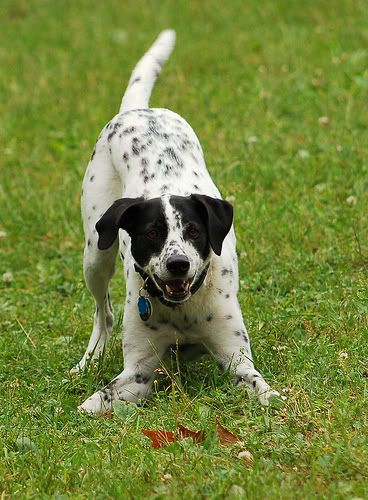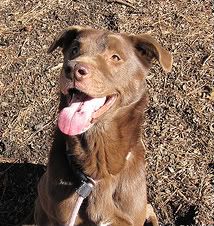One of the things that still amazes me is how people fail to understand what animals are communicating.
When I conducted group dog training classes for the area’s park district, dogs were always happy and excited to come to school.
However, when I started teaching up here I got a lot of flack.
Why?
Because I did not allow choke chains. We used head collars, or the dog’s regular collar, for training and focused on praise more than correction.
When I relocated to a small mountain community, there was not even a pet store. We did have a feed store but everyone was behind the national trend when it came to sophistication over animal care and training.
Back then, Dr Roger Mugford and I shared a mutual friend and he was just introducing the Halti head collar and a citronella spray collar–now a standard in humane animal training methods.
So, when we met in person, I got the prototypes to test here in the USA.
Since I’ve always considered myself pretty progressive in my animal training methodology, I was surprised when lots of people got upset when I was out in public with an outfitted dog.
Members of the general public thought the head collar was a muzzle and got mad.
Muzzles prevent a dog from biting. Usually a muzzle indicates that a dog is a biter and is a protective device to prevent such altercations in public.
Which begs the question, why would you be mad about a dangerous dog wearing a muzzle when it is out in public?
Anyway, people thought it was “cruel” because the were uneducated in the nuances of animal training.
Some were downright ignorant–but I digress–as usual.
Anyway, my students were always happy to come to class. Human students reported that their dogs knew the day they were supposed to go to school and would wait at the door, bring the leash, and other such actions on the day of class.
Not so in a lot of courses.
So how do you know if your pet enjoys training?
It boils down to body language and the dog’s demeanor. Take a close look at Ellie in the next photo. Her mouth is open in a relaxed pant, her ears are up, she is giving good eye contact, and her body posture is relaxed.
When an animal has a positive association with training, he or she learns more easily and is not afraid of making mistakes because that is part of the learning process.
When an animal has a negative association with training, he or she is not apt to explore since negative consequences squelch such exploration.
You can tell the type of association the animal has with training simply by looking at them, or by their actions.
For example, I was called in to help with a young female Bernese Mountain Dog and her doggie delinquent pals. When I arrived the adolescent female did not want to come near me.
During my collection of her history, I found out that there had been a previous “trainer” who had worked with them. I didn’t think much about it initially, thinking it was a temperament and socialization issue that needed more skilled attention.
However, as we continued in our relationship, I discovered how harsh the “trainer” had been with a dog that needed a soft touch and that ended up being eager to learn.
About the third lesson the dog came to greet me and showed that she trusted me.
I’ll spare you the details of all the abuse the dog experienced under a “trainer” (who was really an unskilled hobbiest) but will tell you that when I asked how this dog reacted when the former “trainer” arrived for lessons, the owner said that she ran into the back bedroom to hide and to get as far away from her as the animal could.
Just why my client didn’t think there was anything wrong with the training they were undergoing prior to our relationship confused me.
If your dog is showing signs of discomfort, distrust, and avoiding a trainer you have brought into the home, you should terminate the relationship and find someone that you both like and trust.
The dog will show you through body language and their actions whether or not they are comfortable with the training.
In some cases, the dog will not immediately trust a stranger, but in most cases, they will reveal how the process fits (or doesn’t fit) for them through their behavior and body language.

Photo Uncomfortable Puppy
What does the next photo communicate to you?
Look at the position of the head and ears, the whites of eyes, the tightly closed mouth, and the tense, hunched positioning of the puppy.
It should be easy for you to tell the difference between the photo of the dog performing a sit happily and this puppy who is not comfortable at all.
Look around when you next watch a dog training class and identify what you see.
Which brings me back to the famed television star I wrote about a couple of days ago.
A few comments were let on the Cesar Millan article that were pro which is actually the predominant opinion from the general public.
I want to challenge you the next time you watch the show, to look at the animals closely and see if you can determine if that canine client is comfortable or trusting.
Then, as a contrast, click over an take a gander at Victoria Stillwell’s show and do the same thing.
See if you can determine what the difference is in approach and what the differences are in the demeanor of the animals in each show.
Then come back and leave your comments below!





“Just why my client didn’t think there was anything
wrong with the training they were undergoing prior
to our relationship confused me.”
People just don’t stop to think about their animal’s wants needs and feelings. If a horse is hard to catch (which many are!) it’s the horse’s problem, not the owners.
Want an easy to catch horse? Try changing your behavior and your interactions with the horse.
As for head collars, I think they are beneficial in the right hands (i.e. if the person using the device is educated it the proper use and fitting of it and knows how acclimate the dog to it.)
I’ve seen A LOT of unhappy dogs with head collars, mainly because they are fitted wrong or (usually) because the owner did not take time to train the dog how to wear it.
In one of the classes I took last spring, a participant had head collar on her Springer Spaniel. The dog spent the majority of the class (when they weren’t doing the exercises) lying on the ground trying to get the stupid thing off. Dog was definitely not having fun.
Mary
Hi Mary, as usual it is good to see you comment on the blog!
No, you are right, people don’t think about behavior other than when it is inconvenient or escalated to a point that they must take some action.
Any animal training tool is beneficial in the right hands. You have to train a head collar just like anything else. Horse have to be trained to accept halters on their heads and so do dogs.
There are some trainers that use choke collars without causing injury but ask any veterinary clinic about misuse of the device and tracheae or vertebrae damage…and don’t get me going on those people who use choke chains as collars and then are surprised when the dog chokes to death when the collar catches on something or the dog catches its paw nail in the live ring.
As for the dog fighting the head collar, they can protest if they are not correctly trained or habituated to it. Some of that is because it feels funny and people tend to put pressure on the leash which makes it pull on the dog’s face–kinda like if you pushed on the bridge of the glasses someone is wearing, then it also gives people control over the animal–those critters that are used to having the upper hand tend to hate that.
There are pros and cons for training tools and skill levels of the people using different training methods but I see more animals happy in progressive classes versus the more traditional.